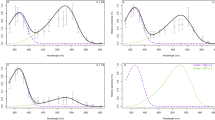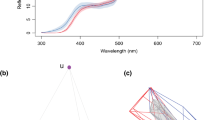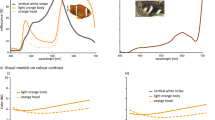Abstract
Relatively little is known about the physical structure and ecological adaptations of elasmobranch sensory systems. In particular, elasmobranch vision has been poorly studied compared to the other senses. Virtually nothing is known about whether elasmobranchs possess multiple cone types, and therefore the potential for colour vision, or how the spectral tuning of their visual pigments is adapted to their different lifestyles. In this study, we measured the spectral absorption of the rod and cone visual pigments of the blue-spotted maskray, Dasyatis kuhlii, using microspectrophotometry. D. kuhlii possesses a rod visual pigment with a wavelength of maximum absorbance (λmax) at 497 nm and three spectrally distinct cone types with λmax values at 476, 498 and 552 nm. Measurements of the spectral transmittance of the ocular media reveal that wavelengths below 380 nm do not reach the retina, indicating that D. kuhlii is relatively insensitive to ultraviolet radiation. Topographic analysis of retinal ganglion cell distribution reveals an area of increased neuronal density in the dorsal retina. Based on peak cell densities and using measurements of lens focal length made using laser ray tracing and sections of frozen eyes, the estimated spatial resolving power of D. kuhlii is 4.10 cycles per degree.






Similar content being viewed by others
Abbreviations
- DW:
-
Disc width
- IR:
-
Infra-red
- LED:
-
Light emitting diode
- MS222:
-
Tricaine methanesulphonate salt
- OLM:
-
Outer limiting membrane
- T 0.5 :
-
Wavelength at 0.5 normalized transmittance
- UV:
-
Ultraviolet
- λ max :
-
Wavelength of maximum absorbance
References
Anctil M, Ali MA (1974) Giant ganglion cells in the retina of the hammerhead shark (Sphyrna lewini). Vis Res 14:903–904
Bowmaker JK, Kunz YW (1987) Ultraviolet receptors, tetrachromatic colour vision and retinal mosaics in the brown trout (Salmo trutta): age-dependent changes. Vis Res 27:2101–2108
Bowmaker JK, Thorpe A, Douglas RH (1991) Ultraviolet-sensitive cones in the goldfish. Vis Res 31:349–352
Bozzano A (2004) Retinal specialisations in the dogfish Centroscymnus coelolepis from the Mediterranean deep-sea. Sci Mar 68:185–195
Bozzano A, Collin SP (2000) Retinal ganglion cell topography in elasmobranchs. Brain Behav Evol 55:191–208
Bozzano A, Murgia R, Vallerga S, Hirano J, Archer S (2001) The photoreceptor system in the retina of two dogfishes, Scyliorhinus canicula and Galeus melastomus: possible relationship with depth distribution and predatory lifestyle. J Fish Biol 59:1258–1278
Braekevelt CR (1994) Retinal photoreceptor fine structure in the short-tailed stingray (Dasyastis brevicaudata). Histol Histopathol 9:507–514
Cohen JL (1989) Functional pathways in the elasmobranch retina. J Exp Zool Suppl 2:75–82
Cohen JL, Hueter RE, Organisciak DT (1990) The presence of a porphyropsin-based visual pigment in the juvenile lemon shark (Negaprion brevirostris). Vis Res 30:1949–1953
Collin SP (1988) The retina of the shovel-nosed ray, Rhinobatos batillum (Rhinobatidae): morphology and quantitative analysis of the ganglion, amacrine and bipolar cell populations. Exp Biol 47:195–207
Collin SP, Hart NS, Shand J, Potter IC (2003a) Morphology and spectral absorption characteristics of retinal photoreceptors in the southern hemisphere lamprey (Geotria australis). Vis Neurosci 20:119–130
Collin SP, Knight MA, Davies WL, Potter IC, Hunt DM, Trezise AEO (2003b) Ancient colour vision: multiple opsin genes in the ancestral vertebrates. Curr Biol 13:R864–R865
Collin SP, Pettigrew JD (1988) Retinal topography in reef teleosts I. Some species with well-developed areae but poorly-developed streaks. Brain Behav Evol 31:269–282
Collin SP, Potter IC, Braekevelt CR (1999) The ocular morphology of the southern hemisphere lamprey Geotria australis Gray, with special reference to optical specialisations and the characterisation and phylogeny of photoreceptor types. Brain Behav Evol 54:96–118
Collin SP, Trezise AEO (2004) The origins of colour vision in vertebrates. Clin Exp Optom 87:217–223
Collin SP, Whitehead D (2004) The functional roles of passive electroreception in non-electric fishes. Anim Biol 54:1–25
Crescitelli F, McFall-Ngai M, Horwitz J (1985) The visual pigment sensitivity hypothesis: further evidence from fishes of varying habitats. J Comp Physiol A Sens Neural Behav Physiol 157:323–333
Denton EJ, Shaw TI (1963) The visual pigments of some deep-sea elasmobranchs. J Mar Biol Assoc UK 43:65–70
Douglas RH, McGuigan CM (1989) The spectral transmission of freshwater teleost ocular media-an interspecific comparison and a guide to potential ultraviolet sensitivity. Vis Res 29:871–879
Dowling JE, Ripps H (1970) Visual adaptation in the retina of the skate. J Gen Physiol 56:491–520
Govardovskii VI, Fyhrquist N, Reuter T, Kuzmin DG, Donner K (2000) In search of the visual pigment template. Vis Neurosci 17:509–528
Gruber SH (1975) Duplex vision in the elasmobranchs: histological, electrophysiological and psychophysical evidence. In: Ali MA (ed) Vision in fishes: new approaches in research. Plenum Press, New York, pp 525–540
Gruber SH, Cohen JL (1978) Visual system of the elasmobranchs: state of the art 1960–1975. In: Hodgson ES, Mathewson RF (eds) Sensory biology of sharks, skates, and rays. Office of Naval Research, Arlington, pp 11–116
Gruber SH, Hamasaki DH, Bridges CDB (1963) Cones in the retina of the lemon shark (Negaprion brevirostris). Vis Res 3:397–399
Gruber SH, Loew ER, McFarland WN (1991) Rod and cone pigments of the Atlantic guitarfish, Rhinobatos lentiginosus Garman. J Exp Zool Suppl 5:85–87
Hart NS (2002) Vision in the peafowl (Aves: Pavo cristatus). J Exp Biol 295:3925–3935
Hart NS (2004) Microspectrophotometry of visual pigments and oil droplets in a marine bird, the wedge-tailed shearwater Puffinus pacificus: topographic variations in photoreceptor spectral characteristics. J Exp Biol 207:1229–1240
Hart NS, Lisney TJ, Collin SP (2006) Visual communication in elasmobranchs. In: Ladich F, Collin SP, Moller P, Kapoor BG (eds) Fish communication. Science Publishers, Inc., Enfield, pp 337–392
Hart NS, Lisney TJ, Marshall NJ, Collin SP (2004) Multiple cone visual pigments and the potential for trichromatic colour vision in two species of elasmobranch. J Exp Biol 207:4587–4594
Hawryshyn CW, Hárosi FI (1994) Spectral characteristics of visual pigments in rainbow trout (Oncorhynchus mykiss). Vis Res 34:1385–1392
Heath LA, Wilkie SE, Bowmaker JK, Hunt DM (1997) The rod and green cone opsins of two avian species, the budgerigar, Melopsittacus undulatus, and the mallard duck, Anas platyrhynchus. Gene 204:121–126
Hueter RE (1980) Physiological optics of the eye of the juvenile lemon shark (Negaprion brevirostris) [Masters thesis]. University of Miami, Coral Gables
Hueter RE (1991) Adaptations for spatial vision in sharks. J Exp Zool Suppl 5:130–141
Hueter RE, Mann DA, Maruska KP, Sisneros SA, Demski LS (2004) Sensory biology of elasmobranchs. In: Carrier JC, Musick JA, Heithaus MR (eds) Biology of sharks and their relatives. CRC Press, New York
Hughes A (1977) The topography of vision in mammals on contrasting lifestyles: comparative optics and retinal organization. In: Autrum H, Jung R, Loewenstein WR, MacKay DN, Teuber HL (eds) Handbook of sensory physiology, vol VIII/5. Springer, Berlin Heidelberg New York, pp 613–756
Jacobs GH (1981) Comparative color vision. Academic, New York
Kohbara J, Niwa H, Oguri M (1987) Comparative light microscopic studies on the retina of some elasmobranch fishes. B Jpn Soc Sci Fish 53:2117–2125
Last PR, Compagno LJV (1999) FAO specie identification guide for fishery purposes. In: Carpenter KE, Niem VH (eds) The living marine resources of the Western Central Pacific, vol 2. Batoid fishes, chimaeras and bony fishes part 1 (Elopidae to Linophrynidae). FAO, Rome
Last PR, Stevens JD (1994) Sharks and Rays of Australia. CSIRO, Australia
Litherland L (2001) Retinal topography in elasmobranchs: interspecific and ontogenetic variation [Honours thesis]. University of Queensland, Australia
Logiudice FT, Laird RJ (1994) Morphology and density distribution of cone photoreceptor in the retina of the Atlantic stingray, Dasyatis sabina. J Morphol 221:277–289
Losey GS, McFarland WN, Loew ER, Zamzow JP, Nelson PA, Marshall NJ (2003) Visual biology of Hawaiian coral reef fish. I. Ocular transmission and visual pigments. Copeia 2003:433–454
MacNichol EF (1986) A unifying presentation of photopigment spectra. Vis Res 26:1543–1556
Maruska KP (2001) Morphology of the mechanosensory lateral line system in elasmobranch fishes; ecological and behavioral considerations. Environ Biol Fishes 60:47–75
Maruska KP, Tricas TC (1998) Morphology of the mechanosensory lateral line system in the Atlantic stingray, Dasyatis sabina: the mechanotactile hypothesis. J Morphol 238:1–22
Matthiessen (1880) Untersuchungen über den Aplanatismus und die Periscopie der Krystallinsen des Fischauges. Pfügers Arch Gesamate Physiol Menschen Tiere 21:287–307
McEachran JD, Aschliman N (2004) Phylogeny of Batoidea. In: Carrier JC, Musick JA, Heithaus MR (eds) Biology of sharks and their relatives. CRC Press, New York
McFarland WN (1986) Light in the sea-correlations with behaviors of fishes and invertebrates. Am Zool 26:389–401
McFarland WN (1991) Light in the sea: the optical world of elasmobranches. J Exp Zool Suppl 5:3–12
McFarland WN, Loew ER (1994) Ultraviolet visual pigments in marine fishes of the family Pomacentridae. Vis Res 34:1393–1396
Mednick AS, Springer AD (1988) Asymmetric distribution of retinal ganglion cells in goldfish. J Comp Neurol 268:49–59
Munz FW, McFarland WN (1973) The significance of spectral position in the rhodopsins of tropical marine fishes. Vis Res 13:1829–1874
Neumayer L (1897) Der feinere Bau der Salachier Retina. Archiv Mikroskopishes Anat 48:83–111
Peterson EH, Rowe MH (1980) Different regional specializations of neurons in the ganglion cell layer and inner plexiform layer of the California horned shark, Heterodontus francisci. Brain Res 201:195–201
Raschi WC (1986) A morphological analysis of the ampullae of Lorenzini in selected skates (Pisces, Rajoidae). J Morphol 189:225–247
Schaper A (1899) Die nervösen Elemente der Selachier-Retina in Methylenblaupräparaten. Nebst einigen Bemerkungen über das “Pigmentepithel” und die konzentrischen Stützzellen. Festschrift zum 70ten Geburtstag von Carl von Kupffer. Gustav Fischer, Jena, pp 1–10
Shand J, Hart NS, Thomas N, Partridge JC (2002) Developmental changes in the cone visual pigments of black bream Acanthopagrus butcheri. J Exp Biol 205:3661–3667
Siebeck UE, Marshall NJ (2000) Transmission of ocular media in labrid fishes. Philos Trans R Soc Lond B Biol Sci 355:1257–1261
Siebeck UE, Marshall NJ (2001) Ocular media transmission of coral reef fish-can coral reef fish see ultraviolet light? Vis Res 41:133–149
Sillman AJ, Letsinger GA, Patel S, Loew ER, Klimley AP (1996) Visual pigments and photoreceptors in two species of shark, Triakis semifasciata and Mustelus henlei. J Exp Zool 276:1–10
Sivak JG (1976) The accommodative significance of the “ramp” retina of the eye of the stingray. Vis Res 16:945–950
Sivak JG (1978) Optical characteristics of the eye of the spiny dogfish (Squalus acanthias). Rev Can Biol 37:209–217
Snyder AW, Miller WH (1977) Photoreceptor diameter and spacing for highest resolving power. J Opt Soc Am 67:696–698
Stone J (1981) The wholemount handbook: a guide to the preparation and analysis of retinal wholemounts. Clarendon Press, Kensington
Tester AL, Kato S (1966) Visual target discrimination in blacktip sharks (Carcharhinus melanopterus) and grey sharks (C. menisorrah). Pac Sci 20:461–471
Tricas TC, Deacon K, Last P, McCosker JE, Walker TI, Taylor L (1997) Sharks and rays. Harper Collins, London
Vihtelic TS, Doro CJ, Hyde DR (1999) Cloning and characterization of six zebrafish photoreceptor opsin cDNAs and immunolocalization of their corresponding proteins. Vis Neurosci 16:571–585
Walls GL (1942) The vertebrate eye and its adaptive radiation. Cranbook Press, Bloomfield Hills
Wässle H, Riemann HJ (1978) The mosaic of nerve cells in the mammalian retina. Proc R Soc Lond B Biol Sci 200:441–461
Acknowledgments
The authors would like to first thank two anonymous reviewers for helpful comments on improving the manuscript. The authors would also like to thank Mike Bennett, Simon Pierce, Scott Cutmore, Peter Kyne, Joanna Stead, Tina Chua, Justin Marshall and the staff of the University of Queensland Moreton Bay Research Station. This work was funded by ARC Discovery Grants DP0558681 and DP0558844, NHMRC Project Grant 179837, the American Elasmobranch Society (Donald R. Nelson Behaviour Research Award), and Sigma Xi.
Author information
Authors and Affiliations
Corresponding author
Rights and permissions
About this article
Cite this article
Theiss, S.M., Lisney, T.J., Collin, S.P. et al. Colour vision and visual ecology of the blue-spotted maskray, Dasyatis kuhlii Müller & Henle, 1814. J Comp Physiol A 193, 67–79 (2007). https://doi.org/10.1007/s00359-006-0171-0
Received:
Revised:
Accepted:
Published:
Issue Date:
DOI: https://doi.org/10.1007/s00359-006-0171-0




